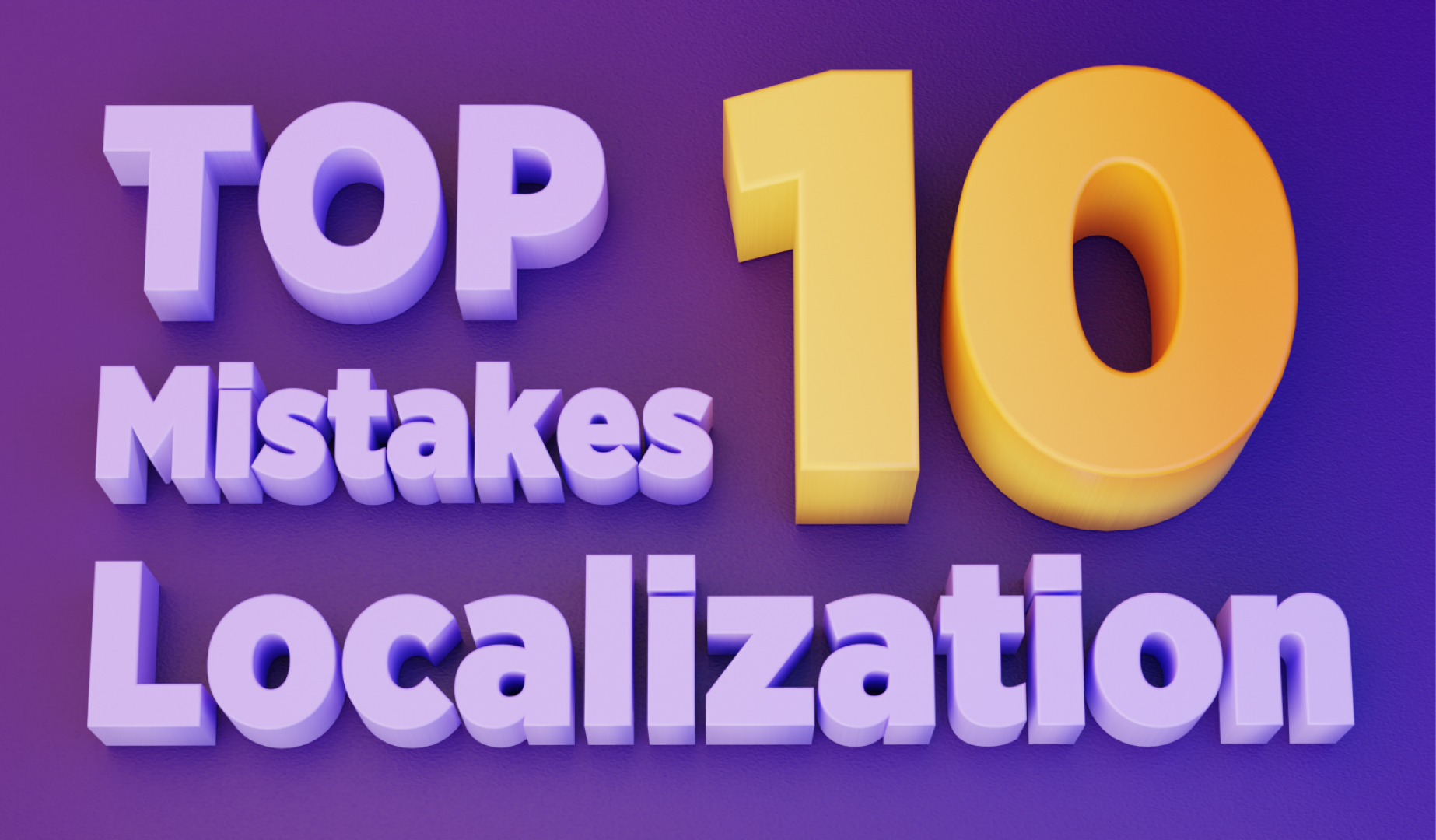As businesses expand globally, effective localization becomes crucial to ensuring success in new markets. Localization is more than just accurate translation; it involves adapting content to fit the target market and target language. However, even the best companies can make costly mistakes when their localization team does not scrutinize every part of the process.
In this article, we’ll review the top 10 common localization mistakes that can harm your business, using real-life examples to show how these errors can be avoided.
Top 10 Localization Mistakes to Avoid
1. Over-Reliance on Machine Translation
Translation software is developing at breakneck speed, improving practically daily. However, while translation tools such as Google Translate and DeepL have advanced rapidly, they are imperfect. Machine translations often miss cultural context, subtle nuances, or idiomatic expressions, which can lead to misinterpretation. No need to mention that it will not do your business any good in the end.
Real-Life Example:
When Microsoft rolled out its latest XBOX console update in Germany in 2022, they made a common localization error by failing to properly translate store listings and support materials. One notable mistake involved translating the word "Save" (referring to storing progress) as "Save money," leading to confusion and frustration in the German gaming community.
How to Avoid It:
Use automated translators in combination with human oversight, as offered by platforms like Localit. Localit’s AI-driven platform integrates machine translation with human review and integrated chats that allow for real-time brainstorming and suggestions, ensuring that speed and accuracy are maintained without sacrificing quality.
2. Ignoring Cultural Context
Localization is about more than just language — it’s also about culture and cultural references. Failing to consider local customs, traditions, and values when adapting content can lead to misunderstandings, or worse, offend your audience.
Real-Life Example:
In China, Pepsi translated its slogan "Pepsi Brings You Back to Life" as "Pepsi Brings Your Ancestors Back from the Grave." This culturally inappropriate message was not well-received and led to significant backlash.
How to Avoid It:
Try to involve native speakers and cultural consultants who understand the local nuances. This way, you will ensure that your business will not falter and suffer reputation damage.
3. Direct Translation of Idioms and Humor
Humor and idiomatic expressions rarely make sense if the direct translation process is employed. What’s funny in one language and culture may be offensive or confusing in different languages. Misunderstood idioms can make your brand seem out of touch or unprofessional.
Real-Life Example:
When KFC entered the Chinese market, their slogan "Finger-lickin' good" was mistranslated as "Eat your fingers off," resulting in poor brand perception among local consumers.
How to Avoid It:
Use transcreation, which goes beyond simple translation to adapt idioms, humor, and slogans to the target audience. If that sounds too complicated, attempt to convey meanings rather than words in collaboration with native speakers, a localization specialist, or experienced marketers from the given region.
4. Failure to Adapt to Local Formats
Date, time, currency, and measurement formats vary widely between countries. If you don’t adapt these aspects for local audiences, it can lead to confusion and a poor user experience.
Real-Life Example:
When Yahoo! Japan collaborated with Alibaba for an e-commerce venture, they initially displayed prices in yen instead of converting them to yuan for Chinese users in their website localization. This mistake led to customer confusion and a significant drop in sales.
How to Avoid It:
Ensure that you are adapting every aspect of your content for local conventions, from currency to date formats to avoid localization mistakes. Paying extra attention to these details will pave the way for your company's future success.
5. Choosing a Wrong TMS
TMS stands for translation management service and is crucial for your localization project. Choosing the right partner in this process means taking a huge step towards the success of your project. However, failing to understand your capabilities and recognizing the shortcomings of certain platforms can result in delays and frustration. This is why it is vital to choose a TMS based on your goals and budgets for a perfect match.
How to Avoid It:
Research the market and what's available out there. But to save your time, here are a few ideas:
Localit: a brand new affordable AI-driven software to localize any content. Tailor-made for smaller companies and aspiring startups that have limited budgets, appreciate high processing speed, and want to get their project done quickly without compromising quality.
Smartling: it offers enterprise-level features but often comes with a hefty price tag that may not be justified for smaller businesses. Its focus on large-scale operations makes it less accessible and overly complex for startups or companies on a tighter budget. If you’re looking for a cost-effective, efficient solution without sacrificing quality, there are more user-friendly alternatives.
Lokalise: Lokalise is a solid platform for agile teams, but its steep learning curve and higher pricing can make it less appealing for smaller businesses. If simplicity, speed, and affordability are your top priorities, there are better options available.
6. Neglecting User Interface (UI) Localization
Your app, software, or website may need more than just text translation — it may require changes in layout, fonts, and colors. For example, right-to-left scripts, like Arabic or Hebrew, need special attention to ensure your UI remains functional. Vertical writing (top to bottom) is also sometimes used in such media as manga, restaurant menus, and road signs in such East-Asian languages as Chinese and Japanese. These details must always be kept in mind when localizing content in another language from these regions of the world.
Real-Life Example:
PayPal’s initial expansion into the Middle East failed because the app’s UI wasn’t optimized for right-to-left languages. This made the app difficult to navigate for Arabic-speaking users, leading to a high abandonment rate.
How to Avoid It:
Adapt your UI for local languages and scripts. Conduct prior research on the language to make sure there are no hidden surprises on the way to your project's success. Among all the localization best practices, this one is often overlooked or misunderstood.
7. Skipping Localization Quality Assurances
Localization isn’t finished when the content is translated. It’s essential to test localized content to ensure it functions properly and doesn’t have any technical or linguistic errors. Failing to do so can lead to poor customer experiences.
How to Avoid It:
Always include a rigorous testing phase in your localization process. Don't skip this part, version control is important! It's tedious but it will be worth it in the end.
8. One-Size-Fits-All Approach for Different Regions
Using the same localization approach for every market can result in subpar outcomes. Each market has different preferences and challenges that require a tailored strategy.
Real-Life Example:
IKEA initially used the same catalog for the Middle East as for other regions, featuring images of women without considering cultural sensitivities. They had to later re-edit the catalog to suit the market better.
How to Avoid It:
Tailor your localization efforts for each specific market. Appealing to the target audiences is easier when you understand how they think and what they consider appropriate. Practices vary from region to region, don't forget about this.
9. Inconsistent Terminology
Consistency is key to ensuring that your brand’s messaging stays clear. If you use different terms for the same product or service across various localized versions, it can confuse customers and damage your brand’s credibility.
How to Avoid It:
Use a localization platform with a built-in chat like Localit that offers communication opportunities for your team. With these chats in place, you can instantly request extra attention to be placed on certain terms and ideas. This will help you avoid the most common localization mistakes.
10. Overlooking Legal and Regulatory Requirements
Different countries have different legal and regulatory standards. If your localized content doesn’t comply with local laws, you could face fines, product recalls or even bans from entering the market.
How to Avoid It:
Ensure your localized content complies with all local legal and regulatory requirements. Research advertising rules, legislations, and relevant authorities. Study successful cases and review mistakes made by your competitors to avoid the same trap.
Summary: Common Localization Mistakes
Localization is a powerful tool that can help your business grow globally, but it’s not without challenges. By avoiding these common mistakes, you can ensure that your brand resonates with local audiences and avoids costly errors. If you’re looking for a powerful, user-friendly localization platform, Localit is the perfect solution for smaller businesses and startups. Its AI-driven technology offers speed, accuracy, and a convenient UX/UI designed to help you localize efficiently and effectively. Explore more on Localit's website, take its features for a ride with a free plan, and get in touch for more information.
FAQ
1. What is the difference between translation and localization? Translation is the process of converting text from one language to another. Localization, on the other hand, adapts content to fit the cultural, linguistic, and functional expectations of a specific region.
2. Why is localization important for businesses? Localization helps businesses connect with new markets by making content more relevant and accessible to local audiences, which improves customer engagement and loyalty.
3. How does SEO localization differ from standard SEO? SEO localization involves adapting your website’s SEO strategy to fit local search behavior and language, including region-specific keywords, meta descriptions, and search engines.
4. How can I ensure that my localized content is culturally appropriate? Work with native speakers, cultural experts, and local marketers to review your content for local sensitivities.
5. What is transcreation, and when should I use it? Transcreation goes beyond translation by adapting the creative aspects of content, such as tone and style, to fit the local culture. It’s ideal for marketing content, slogans, and ads that need to evoke the same emotional response across regions.

 Bitbucket Integration: Complete Guide to Automated Localization Workflow
Bitbucket Integration: Complete Guide to Automated Localization Workflow ChatGPT-5 Now Available in Localit.io
ChatGPT-5 Now Available in Localit.io Everything You Need to Know about Mobile App Localization: Challenges + Best Practices of Working in a Different Language
Everything You Need to Know about Mobile App Localization: Challenges + Best Practices of Working in a Different Language